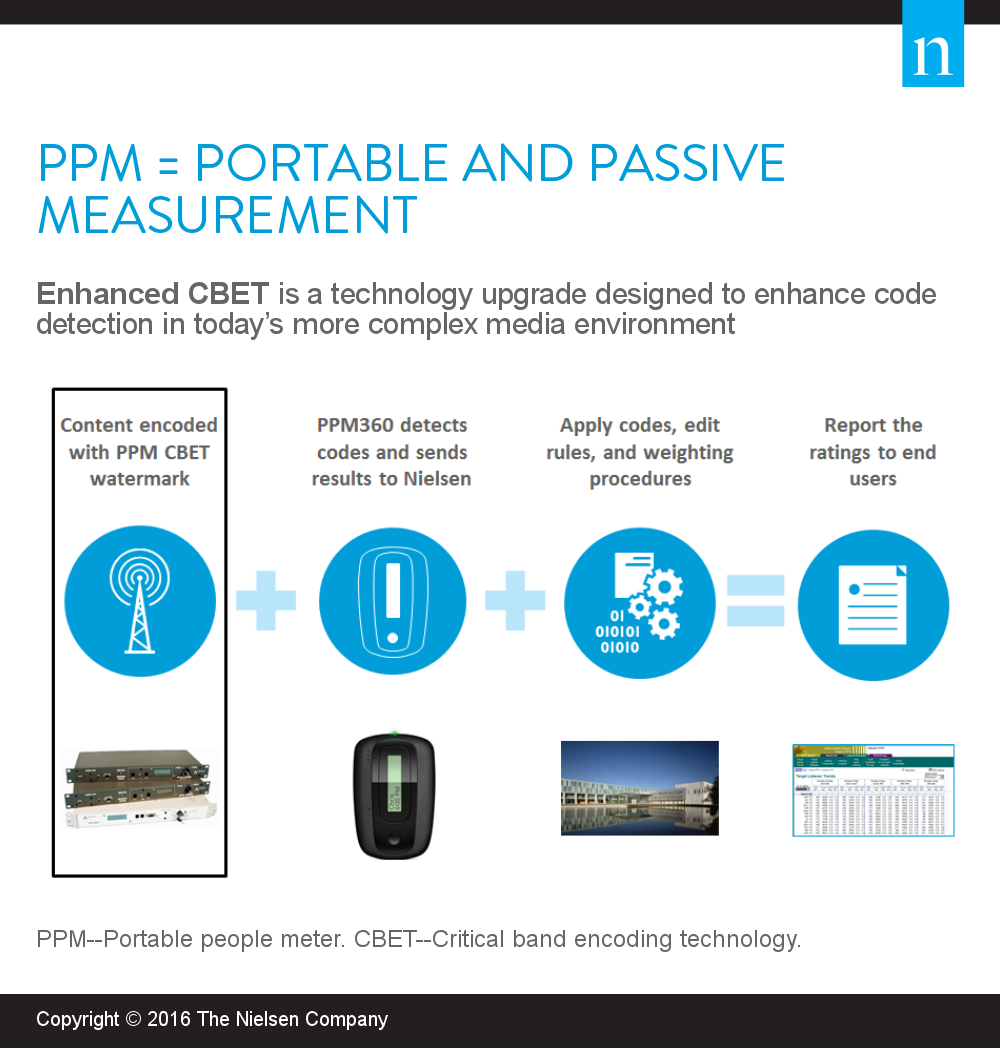
By Arun Ramaswamy, chief engineer, Nielsen and Brad Kelly, managing director, Nielsen Audio
There is a reason Nielsen is so optimistic about audio. Since last February, the average quarter hour (AQH) audience for audio has grown 13% in the portable people meter (PPM) markets among persons aged 6 and older. This year-over-year growth in audience reflects a significant improvement in our PPM measurement system.
PPM is the audio currency in 48 of the top radio markets in the U.S. But what goes into making this currency? With PPM, people in a representative panel each carry a small portable device that detects inaudible codes embedded within broadcast content. PPM’s portability is crucial for measuring audio since most Americans consume radio while on the go—in the car, at work or on the way to shop. In addition, PPM is passive, which means that panelists don’t need to push buttons or remember to write down what they listen to.
Our patented technology for embedding audio content is called critical band encoding technology, or CBET. Broadcasters embed their audio content with these CBET codes, and the PPM devices passively detect each panelist’s exposure to encoded content.
In the last year, we have worked with the industry to update the definition of listening, as part of our continuous improvement program. Our goals were to bring audio’s metrics in line with other media and better reflect a more complex consumer environment featuring greater exposure to a variety of media, as well as more simultaneous usage. The outcome was a significant enhancement to CBET, which we introduced in the fourth quarter of last year.
“We’ve found that enhanced CBET makes the PPM codes stronger and more robust, which improves code detection in challenging acoustic environments such as low volume and/or high background noise conditions,” said Arun Ramaswamy, chief engineer, Nielsen. “Enhanced CBET was thoroughly tested in the lab and the field before it was deployed, and we received extensive feedback from a team of technical experts from various radio groups. We continue to work closely with our clients to implement this technology.”
Field testing found an average increase of about 15% in AQH audience compared with the prior version of CBET among the tested stations. The testing found that enhanced CBET improved detection for stations in all formats. In addition, studio testing demonstrated that enhanced CBET does not compromise audio quality.
Since the roll out began in November 2015, nearly 3,000 U.S. stations have upgraded to enhanced CBET. This represents three-quarters of our subscribers and about 80% of the minutes measured by PPM.
Now that most stations have enhanced CBET, we’re seeing the results in the real world. The 13% year-over-year gain in listening among persons aged 6 and older closely parallels the increases we saw in the field tests. But double-digit growths among hard-to-reach Millennials (aged 18-34) and the key buying demographic of people 25-54 are especially impressive.
//e.infogr.am/js/embed.js?vBKThese effects were also felt across the industry—each of the major format categories gained compared to last year. Spanish Language, Urban, Spoken Word, Adult Contemporary (AC) and Classic Hits/Oldies formats each had increases that exceeded the overall average. //e.infogr.am/js/embed.js?daJ
The adoption and results of enhanced CBET are positive steps forward for the audio industry. This enhancement brings audio metrics closer to how other media are measured and is better suited to today’s more complex media landscape, benefiting both broadcasters and advertisers. And it levels the playing field, because it is available on a system-wide basis and is applied in a unified manner across stations.
Enhanced CBET is one example of how Nielsen continues to innovate to help clients take advantage of new opportunities and demonstrate the value of the radio audience. But it’s just one of many steps we’re taking. We also recently announced the launch of our new Nielsen Digital Audio Ratings service to quantify broadcast radio’s online consumption. Nielsen Digital Audio Ratings provides a comprehensive view of listening across all platforms, including listening on smartphones, tablets and computers. In addition, we recently conducted ground-breaking studies that revealed audio’s ability to drive a strong return on ad spend. For example, one of the studies found that department stores experienced $17 dollars of incremental sales for each ad dollar they spent in radio. These studies have helped radio spotlight its sales and marketing impact for advertisers.
In fact, radio continues to represent a big opportunity for advertisers and retailers. It is the medium with the highest weekly reach—93% of the total population tunes in during the week.[1] Plus, radio users spend nearly two hours and 45 minutes each day with audio, second only to TV and higher than app/web usage on a mobile device and Internet on the PC[2], which is especially noteworthy considering today’s highly fragmented competitive landscape.
“All of these impressive metrics are testaments to the strength and value of the audio medium,” said Brad Kelly, managing director of Nielsen Audio. “We are pleased to find new ways to help the industry monetize its valuable audience and identify emerging opportunities.”
[1] Nielsen Comparable Metrics Report, Q3 2015
[2] Nielsen Total Audience Report, Q4 2015
